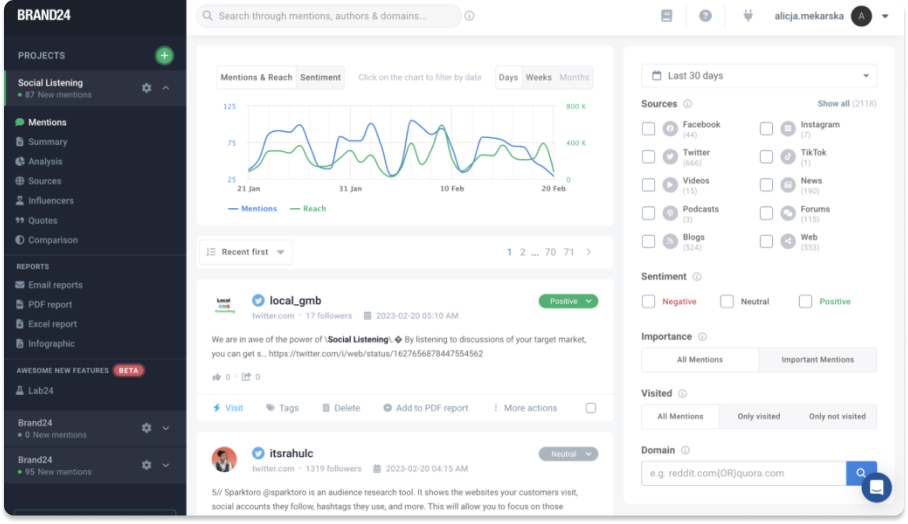Do you track the impact all your hard work has on the bottom line? You know the value of your work: that crucial publication quoting the CEO, a greater share of voice, improved brand sentiment. But how do you package that up to win greater budgets and recognition?
The answer lies in the best Key Performance Indicators (KPIs) for PR. Let’s see how to choose (and interpret) the best of the best to showcase the true value of your work.
Try Prowly's media monitoring free for 7 days
Start tracking your brand and keywords for free (no credit card required) in Prowly.
- Comprehensive monitoring: Track the web and social media mentions.
- Transparent pricing: Plans start at $258/month
- All-in-one platform: Get everything you need in one tool for PR, incl. media database, outreach, reporting, and more
What is a KPI in PR
Key performance indicators for public relations show the numbers on how your PR efforts impact key business objectives.
With these numbers by your side, you can track progress, make informed decisions, and prove the value of your work to your stakeholders. But…
How do you measure PR?
We know that the impact of PR might not be direct: after all, it’s not like in sales where you can draw a straight line between a sales rep’s actions and their secured revenue. Yet, you can demonstrate your PR impact by:
1️⃣ Creating a timeline to illustrate the correlation between your PR campaigns and business results.
2️⃣ Using a line chart to present campaign outcomes against business data over time.
3️⃣ Showing how PR KPIs, like website traffic, brand keyword searches, leads, webinar signups, and app downloads, have changed in relation to your PR activities.
By combining your metrics with data from Google Analytics and CRM sales insights, you can make strong assessments of your PR impact and even measure brand equity.
Why choosing the right KPIs for PR is hard
Historically, PR professionals have struggled with measuring their results, as the industry was pretty young (and offline).
In the absence of PR-specific metrics, many professionals adopted metrics from advertising. And there was no access to data like reach, outlet influence, or to assess the value of mentions.
At the same time, they faced a pressure to produce big numbers. The desire to show impressive results led to the use of metrics that looked good on paper but lacked meaningful insights.
Why do PR pros still rely on inaccurate KPIs for public relations?
The C-suite or clients are used to advertising metrics and money values. And a lot of PR pros just don’t have enough experience (or self-confidence) to convince their stakeholders that this is not the PR way.
Today, however, we have access to a wealth of measurable metrics that can truly showcase the value of PR work. And with these in hand, you can take control of the narrative around your successes.
Public Relations vanity metrics
Some metrics are best left in the past. Let’s take a look at those which don’t supply relevant information, yet are still common in the PR world.
#1 Advertising Value Equivalent (AVE)
AVE attempts to compare a PR mention’s space with paid advertising space.
Obviously, this outdated metric tells you nothing about the quality, impact or credibility of earned media. And it doesn’t help you assess if you’ve reached your target audience or delivered a key message.
Need a living example of why AVE just doesn’t make sense? A PR crisis will boost your AVE – and that’s not what anyone wants.
However, if your stakeholders still want to see AVE among other metrics, Prowly lets you track this and many more that show the real impact of your work.
#2 Domain reach (UVPM)
UVPM, also known as UVM (Unique Visitors per Month), measures the potential size of the audience that could have been reached. However, it's problematic because:
- The "month" timeframe is too broad, considering how quickly news cycles move.
- It doesn't indicate how mentions impact your target group.
#3 Mention estimated reach
Mention estimated reach estimates the number of people who could have seen a particular article within the past month.
While it can be helpful for planning and assessing popular media outlets, it's not meaningful for understanding your impact on your target group or the value of a specific publication.
So while these numbers can look big and impressive on paper, they do little to demonstrate any real value.
Luckily, we now have the tools and technology to leave these metrics where they belong, in the past. So let’s take a look at some numbers that really matter.
#4 Earned media value (EMV)
It’s essentially the same metric as AVE, just under a slightly different name.
Public Relations KPIs: learn where your target audience is
#1 Media tiers
With Media Tiers, you can group all your media by their relative value
- Organizing publishers into Tier 1, Tier 2, etc. based on your target audience’s media preferences.
- Then you can track the number of mentions in each tier to gauge your reach with key demographics.
💡 For example, you can pick out your top 5 articles (Tier 1) from every week and check the quality of the brand mentions using a checklist and scoring system.
With Prowly, you can categorize your media mentions using tags, such as "Tier 1," "Tier 2," and more, to help your clients better understand the impact of your work. This tagging system allows you to easily report outcomes, showing that you have secured a specific number of mentions in Tier 1 media, for example, making it clear where your efforts have had the greatest influence.
#2 Top mentions
Top mentions let you track and identify and analyze your most impactful media coverage.
In Prowly, you can generate a list of your top mentions from specific industry categories to list alongside sentiment metrics, then sort them by domain authority or other relevant factors (like article reach, backlinks, date published etc).
💡 For example, if you want to reach an audience in the advertising industry, you can generate a list of top mentions in articles categorized under the "Advertising Industry" domain. You can then sort these mentions by domain authority, ensuring you target the most influential sources.
You can also choose the top 10 mentions for each of your search queries and display them directly on your dashboard. This way, you can track what coverage provides the best results for your PR activities in real time.
💡 Learn how to create effective media monitoring queries using Prowly from this article based on real-life examples.
#3 Audience analytics
With audience analytics, you can understand which outlets and platforms your target audience engages with most and target appropriate journalists.
Create a true media list: not just a compilation of email addresses:
1️⃣ Identify relevant outlets to your client's industry and target audience.
2️⃣ Pick out your top media choices: the outlets that’ll get special attention from your target.
In Prowly, you can set up filters to find the outlets that match your potential customer’s profile and online activities.
Public Relations KPIs: assess media coverage and reach
Let’s take a closer look at the type of numbers that are now at your fingertips to showcase your PR victories.
#1 Media coverage
You can track the total amount of press coverage your organization or campaign receives. This includes articles, news segments, interviews, and any other type of media featuring your story or keywords.
#2 Overall media presence
It’s essentially synonymous with media coverage. By measuring the entirety of your media coverage, you can gain a comprehensive understanding of your brand's visibility within the media landscape.
#3 Media mentions
Another metric similar to the ones mentioned above is tracking the number of times your brand is mentioned in the media and online. This helps demonstrate media interest, the extent of coverage, and the overall sentiment surrounding your brand.
#4 Potential reach
You can estimate the number of people who could see your content. Now based on circulation, viewership, and followership of the media outlets that covered your story. However, keep in mind that this is considered a vanity metric, so it's advisable to use it alongside other more meaningful metrics.
#5 Impressions
You can get the total number of times your content is viewed across the media landscape.
Social media KPIs for Public Relations
Now you can track mentions and coverage across social media in addition to traditional publications.
#1 Social media engagements
Track audience involvement and interest, such as likes, shares, comments, and retweets (the last branded traces of Twitter).
#2 Sentiment analysis
You can keep tabs on the context and tone of all your media coverage and social media mentions, categorized as positive, negative, or neutral.
Sentiment analysis in PR provides insights into public perception and attitudes towards your brand. You can use media monitoring tools with the algorithms and the help of AI to extract the sentiment from every one of your mentions.
Crisis moments especially put KPIs like sentiment to the test. These 16 PR crisis management examples show what real impact looks like.
In Prowly, it’s displayed and easy to follow: you can keep your finger on the pulse and see what’s going on with just a glance.
Website and SEO metrics for PR
You can now keep tabs on the traffic you redirect to your brand or client’s website and organize it all by its source.
#1 Website traffic
Get the numbers on website traffic, the total number of visitors to your website.
You can break these down by source (organic, direct, referral, social media) to help build a better understanding of the metric. Measure your PR impact with metrics like unique visitors, unique pageviews, bounce rate, and number of referrals from target media publications – you can even find these in Google Analytics.
#2 Earned traffic
Earned traffic is all the traffic you haven’t paid for, such as organic search results, social media mentions, and backlinks from other websites.
PR software like Prowly tracks backlinks and earned traffic on your media monitoring dashboard – where they are counted and displayed automatically. Giving you the numbers to take full credit for your own work.
💡 Further reading:
▪️ What Is Earned Media? Definition, Benefits, Campaign Examples
▪️ Tips for Creating a Successful Earned Media Strategy
▪️ Maximizing PR Strategy with Paid, Owned, and Earned Media
#3 Domain Authority
With domain authority you can keep an eye on the search engine ranking score designed to predict how well your website will rank in search results.
In Prowly, this is measured on a scale from 0 to 100, based on data from Semrush. The higher the score, the stronger the authority. Only a few domains have a 99 score (think Wikipedia or Amazon).
#4 Backlinks
Backlinks are all links on external websites that go back to your content.
In Prowly, you automatically can track the number and quality of websites that link back to you or your client. You can observe and track changes in these rates over the lifetime of your PR campaigns to attribute changes to your PR efforts.
For each mention, Prowly tells you:
- where your website is linked (Backlinks)
- Domain Reach (UVPM) to show you the origin’s popularity among visitors
- Domain Authority to reflect a website's overall quality and SEO performance
- Article Reach indicating how many times the article was viewed
#5 Conversions
Conversions are the end all of you want from your audience, like purchases or sign-ups.
They indicate that your PR or marketing content has achieved bottom line goals. You can now back track your conversions to their source with the help of AI.
#6 Conversion Rate
Conversion rate tells you the percentage of viewers that took the leap from audience to customer. With these in hand, you can assess your impact on the final outcomes.
Advertising and conversion metrics
These metrics are more commonly used in marketing rather than PR. However, if your team handles both PR and marketing, it's important to be familiar with them in.
#1 CPC (Cost Per Click)
For paid campaigns, CPC is the money you pay for each click on your online ads. It lets you see the cost efficiency of your paid campaigns.
#2 CPA (Cost Per Acquisition)
CPA allows you to track how much it costs to acquire a new customer or lead. It’s most common in marketing: you divide the total campaign cost by the final number of acquisitions. Easy peasy.
#3 CTR (Click Through Rate)
Click Through Rate is used in digital campaigns to show the percentage of viewers who click on a specific element of your campaign. This might be a button, a link, an article, etc. With this in hand, you can demonstrate the direct effectiveness of your messaging.
#4 ROAS (Return on Advertising Spend)
ROAS compares the financial outcomes of a campaign with its final costs to assess the profitability of particular campaigns.
Public Relations KPIs: measure effectiveness, quality & brand visibility
But PR is not just about conversions and sales, so let’s take a look at the bread and butter of any PR campaign.
#1 Share of Voice (SoV)
Share of Voice compares your brand's presence in industry conversations to that of your top competitors.
You can now easily use media monitoring tools to measure how your brand is performing against your competition across online content and throughout conversations about your industry.
#2 Quality of Coverage
And of course, you’ll want to assess your media coverage. The quality of coverage is in the level of detail, sentiment, and impact. High-quality coverage is in-depth, positive, and published in reputable outlets.
CTA: Find and track these metrics with the help of Prowly’s AI assisted Media Monitoring
Other relevant KPIs for PR
And of course, the list goes on. Here are some other useful KPI’s you might consider including in your final reports.
#1 Geographical presence
You can analyze the distribution of your media coverage across different regions, indicating where your brand has the most influence and visibility.
#2 Key message penetration
You can accurately measure how effective your core messages are being communicated across media coverage and social media mentions, ensuring you’ve met your communication goals.
#3 Crisis communications effectiveness
You can evaluate the efficiency of your strategies for managing and mitigating negative publicity during a crisis. Track whether and when accurate information is communicated and if your brand reputation is properly protected.
The best tools to measure PR KPIs
Here’s a short list of the best media measurement tools you can use to track PR KPIs.
Prowly
An all-in-one PR solution to manage media relations from A to Z.
- pricing: starts at $258 per month
- free trial: yes, for 7 days
- best for: PR agencies and in-house PR teams (and marketing too!)
- features you’ll find: media monitoring tools, reporting suite, a media database, PR CRM, pitching tools, an AI assistant, and press release creator
Brand24
- pricing: starts st $79/month
- free trial: yes, for 14 days
- works for: PR, marketing and customer research teams
- features you’ll find: mention analysis, reputation management, PR measurement, competitive analysis, and reporting

Hootsuite
- pricing: starts at $99/month
- free trial: yes, for 30 days
- works for: social media measurements
- features you’ll find: social media analytics, publishing and scheduling, social engagement tools
Google Search Console
- pricing: free
- free trial: the tool is free to use
- works for: monitoring your performance in organic search results
- features you’ll find: page performance tracking, keywords ranking, checking impressions and clicks
Wrapping up
Measuring PR success gets easier with the right metrics in hand. By focusing on meaningful KPIs, you can:
👉🏼 gain valuable insights into the effectiveness of your campaigns
👉🏼 demonstrate your impact on business objectives
👉🏼 continuously refine and improve your strategies
🗝️ The key is to choose metrics that align with your specific goals and provide actionable insights.
Ready to take your PR measurement to the next level?
Consider using a comprehensive PR software tool that can help you track these KPIs effortlessly and free up your time to focus on what you do best – crafting compelling narratives and building strong relationships.
With the right tools and metrics at your disposal, you'll be well-equipped to showcase the true value of your PR efforts and drive your organization's success.

